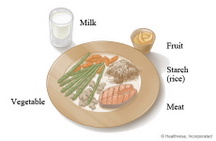
Sample Lunch Plate
Courtesy Healthwise, Inc.
Diabetes: The Plate Format
For people living with diabetes it is important to keep blood sugar levels within a safe range. Carbohydrate is the nutrient that most affects blood sugar levels. Usually, the more carbohydrate eaten, the more the blood sugar rises. A plate format is a simple way to help people with diabetes plan a balanced diet. It helps people with diabetes to plan their meals by visualizing how much space each food should take on a plate. Anyone can use the plate format to maintain a healthy diet and to decrease the chances of having heart disease and other conditions.
Three Benefits of the Plate Format
• Will help you spread carbohydrate throughout the day, which will help keep your blood sugar level within your target range.
• It is an easy and simple way to plan meals until you have more time to learn about other meal planning methods for diabetes.
• It can be used along with other meal-planning methods, such as carbohydrate counting or the food guide for diabetes.
A Typical Plate Meal
• Bread, starchy foods, or grain in one quarter of the plate.
• Meat or another form of protein in another quarter of the plate.
• Vegetables (optional on a breakfast plate) in half of the plate.
• 1 small piece of fruit outside the plate.
• 1 cup milk or yogurt or half cup ice cream outside the plate.
If you take insulin, you may also need snacks between meals and at bedtime. For those snacks, you can choose one serving from the grain, starchy foods, milk, or fruit group.
 BCDF
BCDF